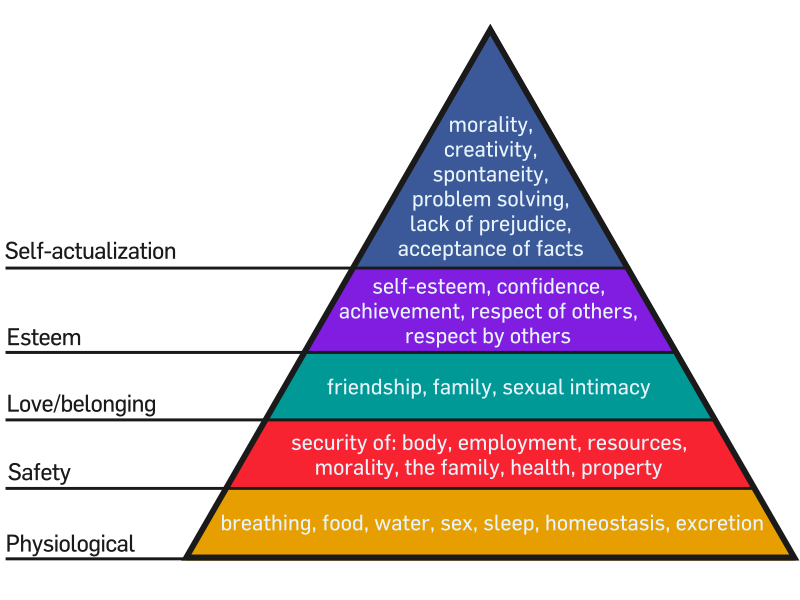All stories are ultimately about humans needs- specifically, a human (or human-like being) trying to meet those basic fundamental needs in some way. No matter what the story is about, or how complicated it is, on some level it’s about people trying to meet their needs.
So, what are the basic human needs?
The concept of human needs was first proposed by Abraham Maslow in his 1943 paper “A Theory of Human Motivation” in Psychological Review. Maslow believed that there are things we fundamentally seek out as human beings, and we need these things to live happy lives. The theory goes that if we don’t have these things, we will naturally try to seek them out and find ways to fill them because they really are fundamental to our lives.

Now, there has been arguments made about the hierarchy Maslow originally placed upon those needs, but that doesn’t really matter to us. The key here is that each of those basic needs you see there are so fundamental that if we’re missing them, and our lives are out of balance, we will naturally try to find some way to make them part of our lives again. (Even if we do it in dysfunctional ways, like staying in bad relationships because they still meet our needs in some way.)
Stories then, are also about characters trying to meet human needs, and you could even say that stories are actually teaching people how needs can be fulfilled through action (or inaction.) This is why characters almost always start stories in an unfulfilled state- one where they are missing one of their fundamental needs – and then the story itself is at it’s core about them trying to fill that missing need in their lives.
Very often, the main characters of stories don’t even know what’s missing in their lives, they are trying to fill those needs in an imperfect way or just limp along with those needs unfulfilled. The story, then, on a personal level becomes about them learning what it really is they need to be happy as a person, and then finding a solution to that need. An interesting point, however, is that often the Active Opponent of the story (the antagonist/villain) actually does know what they need (unlike the main character) and is actively trying to get it. The problem is that usually what the main character and their active opponent want is often the same thing, which naturally brings them into conflict.
Okay, enough theory. Let’s look at how some common genre plots match up with the humans needs that drive them.
Physiological
Stories built around physiological needs are going to be primal stories. You don’t get any more basic than this, because these are the essential things that we need to be alive as living things. These are often stories where man is acting on the same level as an animal, and often will be about the less pleasant sides of human nature. However, these can be stories about the triumph of human nature too, like Robinson Crusoe or The Martian, where a human being must pull the basic needs from a harsh environment.
Safety
Safety covers a lot more ground than you might think. Any story where the main character’s goal is to achieve personal safety for themselves, their family, their community, their nation, or something else they deem important, is a safety-based story. Most action movies and superhero movies are ultimately about safety, because the villain will blow up/harm whatever if the hero doesn’t stop them- so the hero must risk personal safety to fight for the greater good of safety for the community. Westerns are also safety-based, since the cowboy hero is fighting to “keep the peace” or “restore order”, which are also codewords for safety. Even Mystery stories are most commonly about safety, since a murderer/criminal is loose and threatening the safety of society and the balance must be restored for there to be social order. Finally, war movies are also about safety- fighting against an invading army or enemy foe for the sake of the safety of country and loved ones. (Mom and Apple Pie!)
Love/Belonging
Since humans are social animals, we generally desire companionship of some kind and want to feel we belong to a greater community. This human need is naturally the realm of Romance movies and other love stories, but it can also be the root of many type of Dramas and Comedies, usually ones built around interpersonal relationships. The main characters in these stories are almost always lonely or isolated in some way, and the story will be about them finding and connecting with others in a deep and meaningful way.
Esteem
This is another one that like Safety, covers a lot more ground than you might think at first. These are stories of achievement and gaining respect (both from others and within yourself), which is why Adventure stories are most often driven by Esteem. Young Adult stories are often Esteem driven too, since both YA and Middle Grade stories are meant for youth who are trying to find their place in the world and are often driven by gaining respect. Pretty much the whole of the Japanese boys comic industry is about Esteem stories as well- the weak and feeble youth who grows in power and stature personally and socially to become a great man.
Self Actualization
This kind of story is a little less common, in no small part because self actualization can be a pretty vague and personal concept. While an audience can easily understand the many variants of the previous four needs, and they can be easily represented on film, self actualization and being your best personal self is a harder thing to capture. You most often see it in novels where the character is trying to figure out their identity and goes on some sort of inward or outward journey to find the missing thing they need to be happy. In movies, you see it in stories like Seven Years in Tibet, Under the Tuscan Sun, and Eat Pray Love, where a character seems to have everything, but can’t find true happiness. Of course, these stories aren’t limited to introspective drama- Rocky is also a story of self actualization, as are many sports dramas which follow similar molds. (Oddly enough, a lot of Best Picture Oscars seem to go to Self Actualization driven movies.)
Now, when talking about a genre matching up with a human need, that’s based on how those genres generally play out. By shifting the human need the main character is seeking to fill, but using the tropes of another genre, you can create all sorts of combinations and situations. You could do a superhero story where the main character is drive by self actualization (One Punch Man), or a horror story which is about the main character finding the community they need during a zombie apocalypse. However, most commonly, you’ll see these human needs matched up with these genres because they’re good fits to motivate the characters in that genre.
And it’s all about motivation – conscious or unconscious – which is what’s driving the character to do what they do. We need main characters to be active, and nothing makes a character more active than trying to fill their needs.
One note- naturally, real people may be seeking to fill more than one of these needs at the same time, but this is a good time to remember that characters aren’t real people. A character having too many needs will usually muddy the story, and it’s best to focus on just one at a time in most stories. That isn’t to say that the character can’t have another need in a different story, but usually just one need, or maybe two conflicting needs, is enough to make a story interesting to the audience.
Also, if you don’t like Maslow’s list, or perhaps think it’s a bit short or unclear, then there are others who have attempted to quantify human needs in different ways. One of these is Professor Steven Reiss, who classified 16 “Desires” that each human being has. His list is meant for use by marketers (almost all modern marketing techniques are based on connecting human needs with products in the minds of consumers) but it can work for writers as well.
Reiss’ List:
- Acceptance – the need to be appreciated
- Curiosity – the need to gain knowledge
- Eating – the need for food
- Family – the need to take care of one’s offspring
- Honor – the need to be faithful to the customary values of an individual’s ethnic group, family or clan
- Idealism – the need for social justice
- Independence – the need to be distinct and self-reliant
- Order – the need for prepared, established, and conventional environments
- Physical activity – the need for work out of the body
- Power – the need for control of will
- Romance – the need for mating or sex
- Saving – the need to accumulate something
- Social contact – the need for relationship with others
- Social status – the need for social significance
- Tranquility – the need to be secure and protected
- Vengeance – the need to strike back against another person
The key is to remember that stories are about people acting to accomplish goals, and that action will most likely be driven by a human need. Matching the right need with the right character can really bring a character to life and help to make a story much more interesting and appealing than it might otherwise be. So know what your character’s needs are, and then make them work to fulfill them- because your reader needs a little adventure in their life.






Lots of good stuff there. Two things I might consider:
– You can MAYBE generalize “safety” down to “homeostasis.” The idea being that both represent a sort of return to “normal.” Characters trying to flee a disaster, catch a murderer (which is WAY out of the norm. Unless you live in Cyberpunk times….) appease their spouse, etc all come out of this need for things to go back to a previous uneventful state.
– Esteem and self actualization are kind of the same thing; at least story-wise since they both manifest the same in execution. It usually plays out…. in both cases…. as a character trying to be the person they KNOW they can be, whether that’s a war hero or Suzie McCheerleader’s boyfriend.
Don C.
I think those are some really good points.
-I would argue that for most, maintaining their normal life becomes a top priority and is intrinsically linked with “safety” in the sense of feeling personally safe and happy. We find comfortable grooves in life and then seek to maintain those grooves as best we can. For many, that can be a strong motivator, and is most often present in stories where the main character loses that normal life and must now find a way to return to it or reconstruct a new normal life- both of which are trying to return to that happy groove.
-I would argue that Esteem and Self-Actualization are a bit different. Esteem is about respect- either the respect of others, or of yourself – while Self Actualization is about finding what makes you truly happy. Self Actualization is definitely a path to Self-Esteem (many argue that the hierarchy of Maslow’s pyramid isn’t quite right), but Self-Esteem can be achieved without Self Actualization through other means.
>I would argue that for most, maintaining their normal life becomes a top priority and is intrinsically linked with “safety” in the sense of feeling personally safe and happy.
I think it’s basically the same thing; just slightly different ways of phrasing it. I like “homeostasis” ‘cos it’s a much broader term and helps keep the concept from becoming a strictly plug and play formula.
>Esteem is about respect- either the respect of others, or of yourself – while Self Actualization is about finding what makes you truly happy.
Well…. I think it depends on the character. Respect matters to some, not others. Again, I think it’s a slightly different way of expressing a similar concept. Esteem and respect are specific types of self-actualization.
Don C.